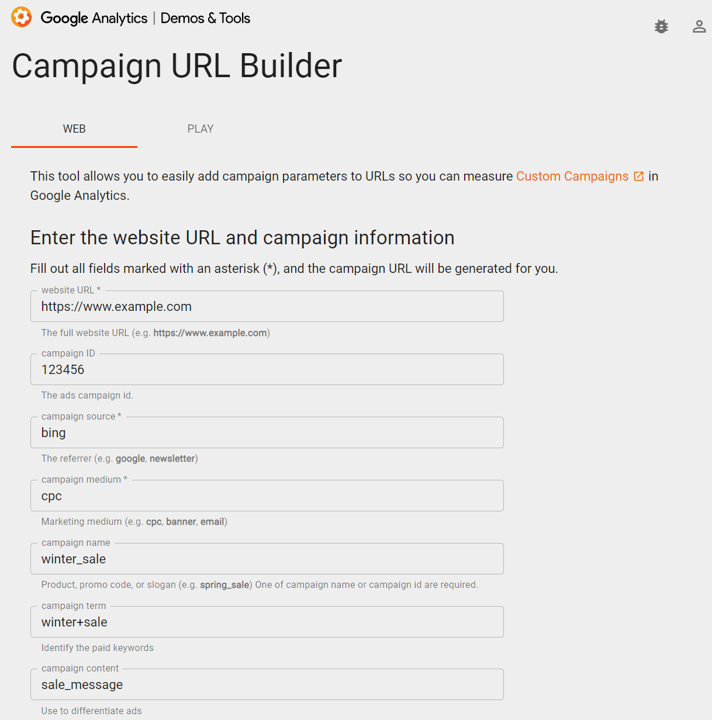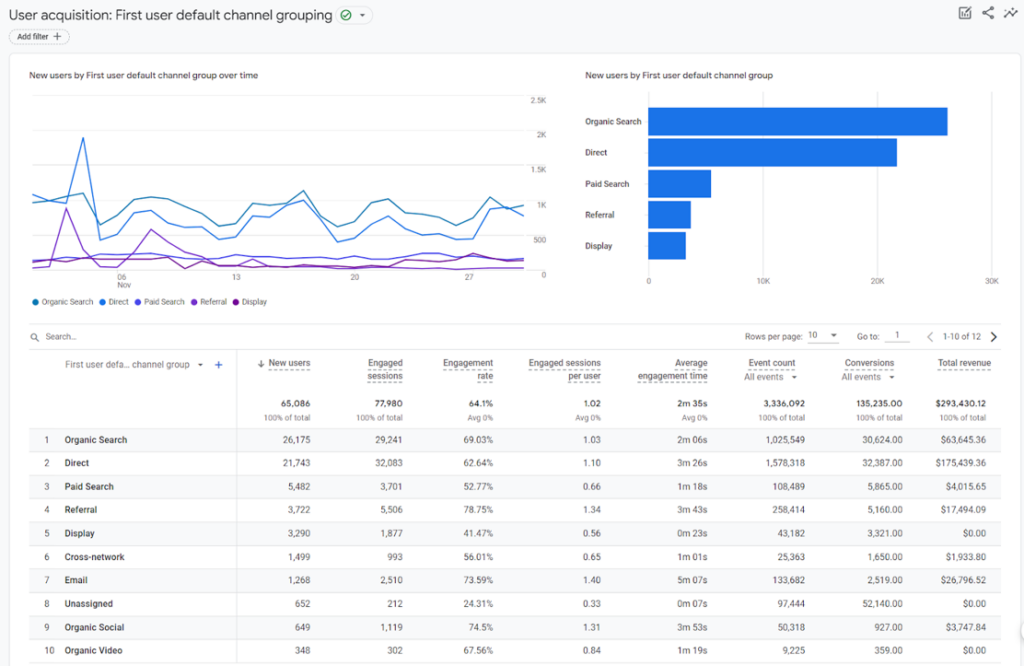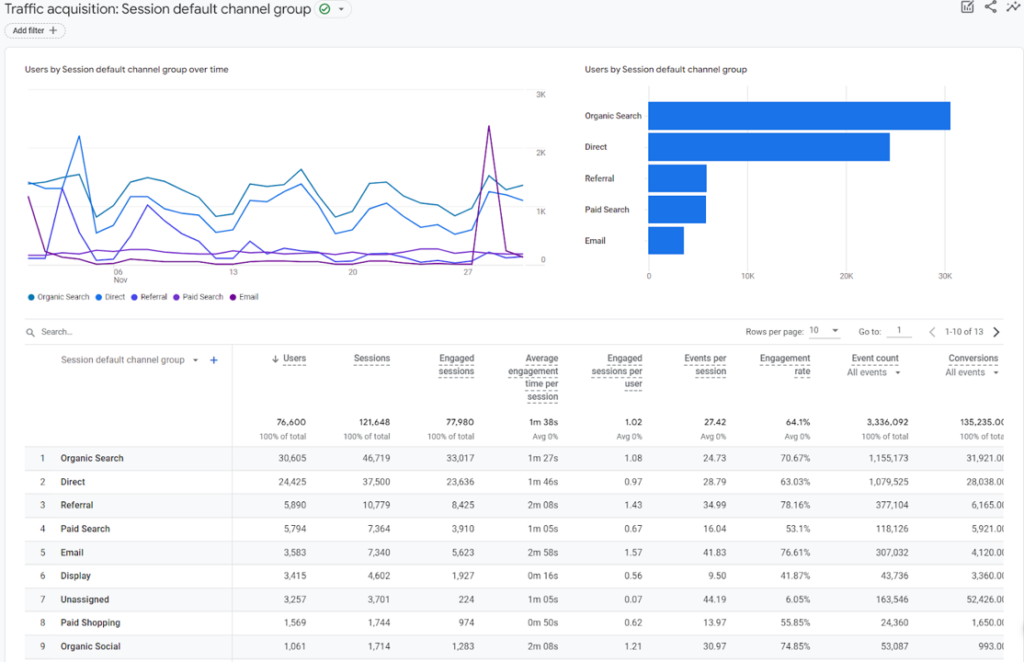Google Analytics 4
UTM tracking has long been an important tool for marketers to customise marketing campaign data collected in Google Analytics. A common question we are being asked is ‘How does UTM tracking work in Google Analytics 4?’
Well, UTM tracking is here to stay in Google Analytics 4, but there are a few new features and data points for you to be aware of.
This article will cover everything from what UTM tracking is, through to how you can use UTM tracking in Google Analytics 4 to understand the performance of your marketing campaigns.
What is UTM tracking?
UTM tracking provides marketers with a way of classifying and enriching marketing campaign data, to understand the performance and efficacy of their marketing campaigns.
For example, UTM tracking has been particularly useful for marketers to report back on the performance of email marketing campaigns, or to differentiate paid advertising campaigns on platforms such as Meta or Bing.
The ‘UTM’ acronym stands for Urchin Tracking Module. At a first glance this may seem like an unusual acronym, but there is some history and logic behind it.
Urchin was a Web Analytics software company which was acquired by Google way back in 2005, to help form the Google Analytics product. The UTM acronym has remained throughout the life of Google Analytics, and will continue to be used in Google Analytics 4.
How does UTM tracking work?
UTM tracking works by appending UTM parameters onto the end of the landing page URL being used for the marketing campaign.
When a URL with UTM parameters is visited, Google Analytics will assign the marketing source, medium and campaign information as reported in these parameters.
The following UTM parameters are recognised by Google Analytics with utm_source, utm_medium and utm_campaign being mandatory.
| Parameter | Description | Example |
| utm_medium | marketing medium | utm_medium=cpc |
| utm_source | marketing source | utm_source=bing |
| utm_campaign | marketing campaign | utm_campaign=winter_sale |
| utm_term | keyword or term | utm_term=wintersale |
| utm_content | campaign content | utm_content=sale_message |
| utm_id | campaign id | utm_id=123456 |
With Google Analytics 4, there are some new parameters, which will be explained later in this article.
An example UTM tracked URL may look something like this
https://www.example.com/landing-page?utm_source=bing&utm_medium=cpc&utm_campaign=winter_sale&utm_id=123456&utm_term=wintersale&utm_content=sale_message
UTM parameters must be defined exactly as shown in the parameter column above and are case sensitive. If you try to create your own parameter names, these will not be recognised and Google Analytics 4 will instead assign the source and medium based on the referral information it automatically collects from the Google Analytics 4 tag.
Google offers a campaign builder to help correctly format your URLs with UTM tracking parameters.

Poor governance of your UTM parameters can quickly lead to inconsistency and duplication within your Google Analytics dataset. We recommend setting up a centralised Google sheet to manage the production of UTM tracked URLs along with adopting a lower casing convention for your UTM parameters values.
Do I need to change the way I build campaign URLs with UTM tracking in Google Analytics 4?
The way marketers build UTM tagged campaign URLs will continue to be exactly the same in Google Analytics 4, keeping things nice and simple for marketers.
When setting up Google Analytics 4, your data will be sent to a brand new Google Analytics 4 property. As you will be starting data collection to a brand new property in Google Analytics 4, with no history, we would strongly recommend you take this opportunity to audit your current UTM tracking process.
The move to Google Analytics 4 provides a great opportunity to iron out previous inconsistencies you may have had with your UTM creation and governance processes (e.g. mixed casing, duplicate naming, multiple delimiter types) so that you start collection in Google Analytics 4 in a maintainable way that avoids unnecessary duplication.
Please speak to us if you would like any support or consultancy around auditing your UTM tracking configuration ahead of moving to Google Analytics 4.
Have the UTM parameters changed with Google Analytics 4?
The six UTM parameters referenced earlier in this article will all still function with Google Analytics 4, meaning little change for marketers in generating UTM tracked parameters for their marketing campaigns.
There are also some new UTM tracking parameters that can be used in Google Analytics 4, these new parameters are detailed in the table below:
| Parameter | Description |
| utm_source_platform | split by platform (e.g. DV360) |
| utm_campaign_id | identify specific product promotions |
| utm_creative_format | split by creative type (e.g. video, native) |
| utm_marketing_tactic | split by tactic (e.g. prospecting) |
These four new parameters will prove useful, and more flexible, to add additional granularity around tracking marketing platform, type of creative and marketing tactics. All four new parameters are optional.
As of December 2022, creative format and marketing tactic are not available as dimensions in the Google Analytics 4 interface, or within the BigQuery export schema, which somewhat limits how you can use these dimensions.
Will UTM parameters generate a new session in Google Analytics 4?
In Universal Analytics, and preceding versions of Google Analytics, if a source, medium or campaign changes mid-session then a new session would begin with the new source, medium or campaign data.
This logic could prove problematic for UTM tracked URLs. If UTM tracking was used in ways that it was not intended, for example on internal site links, then it would result in incorrect attribution and inflated session based metrics.
With Google Analytics 4, if a source, medium or campaign changes mid session then a new session will not begin and session count will not increase.
Whilst this resolves the accuracy issues of using UTM tracking in ways that are not intended, we still recommend avoiding using UTM links for internal site links. Utilise the new flexible event based schema in Google Analytics 4 to distinguish between different elements of your website links.
This change in logic can also mean that the session count you are recording in Google Analytics 4, is lower than what you are recording in Universal Analytics.
How can I analyse UTM parameters in the Google Analytics 4 interface?
The information that you collect via the UTM parameters continues to be stored as dimensions in Google Analytics 4.
The Google Analytics 4 dataset has been enhanced to split out UTM dimensions based on ‘first user’ scope (i.e. how the user was first acquired) and ‘session’ scope (i.e. how the user was acquired in current session) to provide granularity and a new way of analysing your data.
Let’s talk through an example of how this works:
- Let’s say I were to access your site for the first time via a UTM tracked link from an email campaign.
- Then, I accessed your site again via a paid advert on Facebook that was UTM tracked.
If I were analysing data in Google Analytics 4 based on ‘first user’ dimensions then the dimension ‘First user medium’ would be assigned email in the example above, due to my first ever visit to your site being from a UTM tracked link from email. When you are navigating the user acquisition report in Google Analytics 4, it is based on these ‘first user’ dimensions.

If I were analysing data in Google Analytics 4 based on session dimensions, then the dimension ‘Session source’ would be assigned to facebook due to my most recent visit to your website being from a paid advert on Facebook. When you are navigating the traffic acquisition report in Google Analytics 4, it is based on these session dimensions.

As mentioned earlier in the article, as of December 2022 the new UTM parameters of utm_creative_format and utm_marketing_tactic are not currently available as dimensions in the Google Analytics 4 interface.
How can I analyse UTM parameters in Google BigQuery?
One of the many new features and advantages of Google Analytics 4 is the ability to export daily data to BigQuery. This feature is available to all customers in Google Analytics 4 whereas historically BigQuery exports were only ever available to 360/premium users of Universal Analytics.
One important point to be aware of is that not all dimensions are surfaced within the BigQuery export schema. This means there will be some data and analysis that will require complex SQL queries to be built in BigQuery.
The BigQuery export schema can be found here. According to the definitions in this documentation, the traffic source information in the BigQuery export is based only on when the user was first acquired. Therefore calculating session based attribution data, to match the traffic acquisition reporting in the Google Analytics 4 interface, is far from a straightforward task in Google BigQuery, and is worth bearing in mind if you are regularly analysing this type of data in Google BigQuery.
Key takeaways and closing thoughts
UTM tracking remains a key component of Google Analytics 4, and the approach to using UTM tracking to provide customised source medium and campaign information has not changed.
This is reassuring for marketers as part of their adoption of Google Analytics 4, as it means very little needs to change from a process perspective.
Using the upcoming launch of Google Analytics 4, we recommend taking this as an opportunity to review your UTM governance and infrastructure. With Google Analytics 4, you are effectively starting from a blank sheet of paper so it is a perfect time to iron out any historical issues with your UTM tracking to start data collection on the right foot.
When it comes to analysing the UTM data in Google Analytics 4, there are a number of changes and nuances to be aware of:
- There are four new UTM parameters within Google Analytics 4 (utm_source_platform, utm_campaign_id, utm_creative_format, utm_marketing_tactic) providing new, more granular ways to capture data.
- As of December 2022, dimensions do not exist in Google Analytics 4 for utm_creative_format and utm_marketing_tactic, meaning that data cannot currently be analysed for these parameters either in the Google Analytics 4 interface or BigQuery.
- When a source, medium or campaign changes mid session, a new session will not start in Google Analytics 4 and session counts will not increase. Whilst this helps address issues typically associated with incorrect use of UTM tracking (e.g. using incorrectly on internal site links) we still continue to recommend that UTM tracking is only used for its intended purpose (tracking referral information from marketing campaigns).
- When analysing dimensions in Google Analytics 4 that are associated with UTM tracking parameters, dimensions are now available on a ‘first user’ scope (based on initial acquisition) and ‘session’ scope (based on current session). This provides new ways to analyse UTM based data in Google Analytics 4, to better understand your website audience.
- There is limited information on dimensions associated with Google Analytics 4 in the BigQuery data export. According to the BigQuery event schema documentation produced by Google, the traffic source information collected in BigQuery is based on first user acquisition only. Analysing session scoped source, medium and campaign data will require complex queries to be built in BigQuery.
Please speak to us if you have any questions around how UTM tracking works in Google Analytics 4.